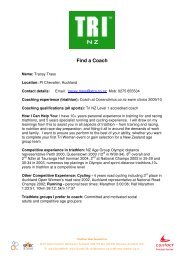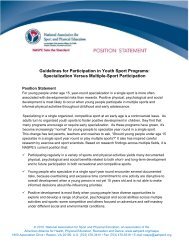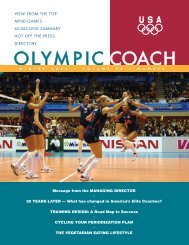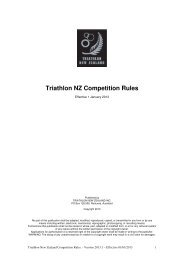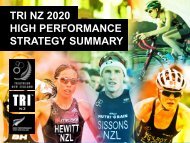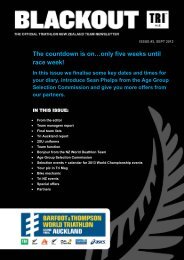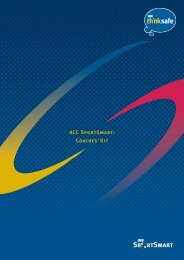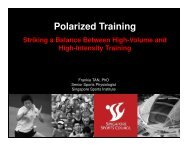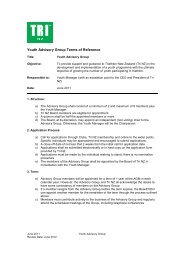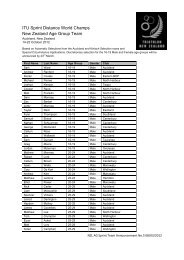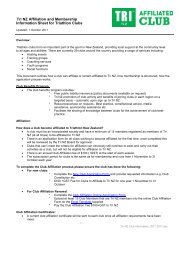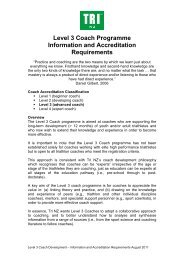The Science of Cycling - IngentaConnect
The Science of Cycling - IngentaConnect
The Science of Cycling - IngentaConnect
Create successful ePaper yourself
Turn your PDF publications into a flip-book with our unique Google optimized e-Paper software.
<strong>The</strong> <strong>Science</strong> <strong>of</strong> <strong>Cycling</strong>: Part 1 295<br />
racing cyclists. <strong>The</strong>se data are useful in the selection<br />
and subsequent classification <strong>of</strong> cyclists.<br />
Although not to be dismissed as an important<br />
quality for endurance cycling performance, ˙VO2max<br />
alone is not a good predictor <strong>of</strong> endurance perform-<br />
ance when athletes <strong>of</strong> similar endurance ability are<br />
compared. [85] <strong>The</strong> mechanisms that underlie why<br />
lactate parameters provide a better predictor <strong>of</strong> endurance<br />
performance than ˙VO2max continue to be<br />
examined. <strong>The</strong> argument has been presented that<br />
˙VO2max is limited by the oxygen supply to the<br />
muscle mitochondria. [86,87] However, lactate levels<br />
are related to the capacity to transport lactate and<br />
hydrogen ion or proton (H + ) out <strong>of</strong> the muscle<br />
fibres, and the capacity <strong>of</strong> skeletal muscle to take up<br />
lactate.<br />
Central factors are likely to limit ˙VO2max, while<br />
the lactate response to exercise is primarily related<br />
to peripheral factors in the trained musculature.<br />
<strong>The</strong>se factors include the percentage <strong>of</strong> slow-twitch<br />
fibres, the activities <strong>of</strong> key oxidative enzymes and<br />
respiratory capacity. [50,88-91]<br />
France and Vuelta a España was found to be 73.5<br />
mL/kg/min and the LT2 was observed to be 90% <strong>of</strong><br />
˙VO2max. [18] Thus, it is not surprising that Lucía et<br />
al. [70] reported leading time realists <strong>of</strong> the Giro<br />
d’Italia, Tour de France, or Vuelta a España stage<br />
races were able to tolerate high submaximal con-<br />
stant work-loads close to their VT2 or ~90%<br />
˙VO2max for ~60 minutes. A high VT2 is an advan-<br />
tage to the cyclists since mountain stage climbs<br />
lasting 30–60 minutes demand the cyclist work<br />
close to VT2 or onset <strong>of</strong> blood lactate. [38,59] Table<br />
VIII presents the ˙VO2max values recorded for vari-<br />
ous levels <strong>of</strong> male and female road and <strong>of</strong>f-road-<br />
Table VIII. Maximal oxygen uptake ( ˙VO2max) <strong>of</strong> road and <strong>of</strong>f-road<br />
male and female cyclists<br />
Study <strong>Cycling</strong> level ˙VO2max<br />
(mL/kg/min)<br />
Male<br />
Fernández-García et al. [18] Pr<strong>of</strong>essional 73.7<br />
Lucía et al. [34] Pr<strong>of</strong>essional 72.0<br />
Lucía et al. [34] Pr<strong>of</strong>essional 71.3<br />
Lacour et al. [71] Pr<strong>of</strong>essional 70.1<br />
Padilla et al. [38] Pr<strong>of</strong>essional 78.8<br />
Sjogaard [72] Pr<strong>of</strong>essional 71.0<br />
Terrados et al. [73] Pr<strong>of</strong>essional 70.0<br />
Gnehm et al. [74] Elite 69.4<br />
Saltin and Astrand [75] Elite 74.0<br />
Burke et al. [76] Elite 67.1<br />
Hermansen [77] Elite 73.0<br />
Burke [78] Elite 74.0<br />
Coyle et al. [44] Elite 69.1<br />
Stromme et al. [79] Elite 69.1<br />
Wilber et al. [61] Elite (<strong>of</strong>f-road) 79.3<br />
Wilber et al. [61] Elite 70.0<br />
Faria [68] Elite 68.0<br />
Faria et al. [45] Elite 75.5<br />
Lindsay et al. [23] Amateur 65.7<br />
Impellizzeri et al. [80] Amateur 75.9<br />
Lucía et al. [24] Amateur 69.5<br />
Padilla et al. [81] Amateur 66.1<br />
Palmer et al. [55] Amateur 66.7<br />
Palmer et al. [82] Amateur 73.6<br />
Tanaka et al. [83] Amateur 69.4<br />
Hopkins and McKenzie [84] Amateur 68.0<br />
Females<br />
Wilber et al. [61] Elite (<strong>of</strong>f-road) 57.9<br />
Wilber et al. [61] Elite 68.0<br />
6. Anaerobic Power<br />
<strong>The</strong> attainment <strong>of</strong> very high power output during<br />
30 seconds <strong>of</strong> cycle sprinting is derived from the<br />
anaerobic sources <strong>of</strong> phosphocreatine (PCr) degradation<br />
and glycogenolysis ending in lactate production.<br />
<strong>The</strong> most frequently used test to describe anaerobic<br />
power and capacity is the Wingate test. [92] At<br />
the onset <strong>of</strong> sprinting, both the phosphagen and<br />
glycolytic systems are fully activated. [93-95] Accelerated<br />
glycolysis, PCr degradation and oxidative metabolism<br />
provide approximately 50–55%, 23–29%<br />
and 16–25%, respectively, <strong>of</strong> the adenosine triphosphate<br />
(ATP) required by the working muscle during<br />
a 30-second sprint. [5,96-99] Furthermore, resynthesis<br />
<strong>of</strong> ATP to ~80–100% <strong>of</strong> resting value requires 2–4<br />
minutes <strong>of</strong> recovery. [100-102]<br />
For the competitive cyclists, these facts serve as<br />
the foundation for sprinting strategy. Initiation <strong>of</strong><br />
the sprint to the finish too soon will result in a<br />
gradual reduction <strong>of</strong> speed and most certainly a loss<br />
<strong>of</strong> first place. This notion is supported by the fact<br />
that PCr degradation begins at the onset <strong>of</strong> intense<br />
© 2005 Adis Data Information BV. All rights reserved. Sports Med 2005; 35 (4)



